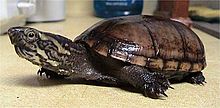Eastern mud turtle
| Eastern mud turtle | |
|---|---|

| |
| Kinosternon subrubrum | |
| Scientific classification | |
| Kingdom: | |
| Phylum: | |
| Class: | |
| Order: | |
| Family: | |
| Genus: | |
| Species: | K. subrubum
|
| Binomial name | |
| Kinosternon subrubrum[1] (Bonnaterre, 1789)[1]
| |
| Synonyms[2] | |
| |
The eastern mud turtle (Kinosternon subrubrum) or common mud turtle[1] is a common species of turtle found in the United States.
Appearance
The eastern mud turtle is a small and often hard to identify species. It measures 3-4 inches in length. The carapace is keel-less, lacks any pattern, and varies in color from yellowish to black. The plastron is large and double hinged, and can be yellowish to brown, and may sometimes have a dark pattern. The chin and throat are a yellowish grey, streaked and mottled with brown, while the limbs and tail are grayish. The eye, or iris, of the eastern mud turtle is yellow with dark clouding, and its feet are webbed.
Ecology
Eastern mud turtles dwell in ponds and other freshwater habitats. They feed mainly on insects and small fish. Raccoons are known to eat this species' eggs, while herons and alligators often hunt the adults.
Distribution
Eastern mud turtles are found in the US states of Alabama, Arkansas, Delaware, Florida, Georgia, Illinois, Indiana, Kentucky, Louisiana, Maryland, Mississippi, Missouri, New Jersey, New York, North Carolina, Oklahoma, Pennsylvania, South Carolina, Tennessee, Texas and Virginia.[1]
In Indiana, the eastern mud turtle is listed as an endangered species.[3]
Subspecies
- Kinosternon subrubrum subrubrum (Type species) - Eastern mud turtle[1]
- Kinosternon subrubrum hippocrpis - Mississippi mud turtle[1]
- Kinosternon subrubrum steindachneri - Florida mud turtle[1]
References
- ^ a b c d e f g h Rhodin, Anders G.J.; van Dijk, Peter Paul; Inverson, John B.; Shaffer, H. Bradley (2010-12-14). "Turtles of the world, 2010 update: Annotated checklist of taxonomy, synonymy, distribution and conservation status". Chelonian Research Monographs. 5: 000.98. Archived from the original (PDF) on 2010-12-15.
{{cite journal}}: CS1 maint: multiple names: authors list (link) - ^ Fritz Uwe (2007). "Checklist of Chelonians of the World". Vertebrate Zoology. 57 (2): 259–260. ISSN 18640-5755. Archived from the original (PDF) on 2010-12-17. Retrieved 29 May 2012.
{{cite journal}}: Unknown parameter|coauthors=ignored (|author=suggested) (help) - ^ Indiana Legislative Services Agency (2011), "312 IAC 9-5-4: Endangered species of reptiles and amphibians", Indiana Administrative Code, retrieved 28 Apr 2012
External links
- Eastern mud turtle - Kinosternon subrubrum Species account from the Towson University Reptiles of Maryland Web Page

